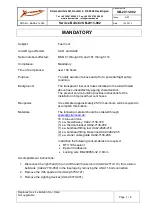
9
In-flight turbulences
Thanks to its low aspect-ratio, the Foxy is a
solid wing. However, it still can be subjected
to turbulences and could suffer the
consequences.
You will always have to pilot your wing and
take the appropriate measures to avoid
collapses.
You always have to adapt your speed and
your incidence angle to the air mass. We
recommend you to be surrounded by
professionals to practice piloting.
As told before, remember that the behavior
of your wing and the way it reacts can
change depending on the wing load.
Anyways, you have to adapt your action on
the brakes to every situation in order not to
over-pilot.
In the following pages, you can find all the
practical information about the Foxy’s
reaction to these maneuvers.
Even if the Foxy is stable, turbulences still can asymmetrically collapse
your wing. It occurs when the pilot doesn’t anticipate an asymmetrical
under-incidence. You will feel a diminution of tension in the brakes. To
avoid the closure, increase the angle of incidence by applying tension
on the brake on the side that is going to close. If the wing still closes, put
weight shift on the open side to reopen it. If it is not enough to reopen,
apply a deep but brief pull on the closed side brake, hand back the
brake immediately. Repeat this move several times if necessary. In
order to keep your course, give priority to weight shift rather than brake.
In a turbulent air mass, a variation of the angle of incidence could lead
to a symmetrical collapse of the Foxy. After a closure of this type, the
wing re-inflates again quite easily on its own. However, you can apply a
brief and deep symmetrical pull on the brakes if necessary. Release
immediately to let the wing fly at its optimum speed.
A spin could be the consequence of piloting mistakes. Flying at low
speeds while engaging a turn by pulling the interior brake (instead of
releasing the exterior one) could lead to a flat spin. The expected
reaction is a surge with an incipient turn of less than 360° before the
return to normal flight. The pilot is expected to anticipate and react in
the right way.




























